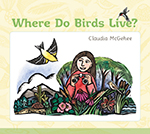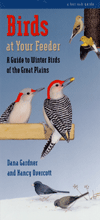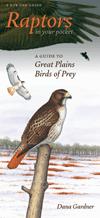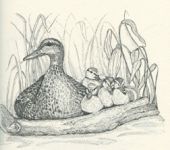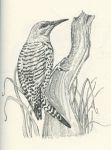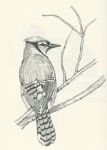Birds Every Child Should Know
“This is a very nice book! Besides being pleasantly thick and crammed with information, it's an example of good writing for young readers. It's clear, not condescending, and does not read as especially dated for all its having been written almost a hundred years ago.Birds Every Child Should Know is a book many a child, and many an adult, should know today.”—Daniel Pinkwater
Originally published in 1907, Birds Every Child Should Know is a collection of storylike descriptions of more than one hundred birds commonly found in the United States. Neltje Blanchan's detailed descriptions of birds—their physical attributes, calls, nesting and mating habits, and other behaviors—are nothing less than enchanting, and some read almost like fairy tales. Take for instance the mockingbird's call:
“when the moonlight sheds a silvery radiance about every sleeping creature, the mockingbird sings to his mate such delicious music as only the European nightingale can rival. Perhaps the stillness of the hour, the beauty and fragrance of the place where the singer is hidden among the orange blossoms or magnolia, increase the magic of his almost pathetically sweet voice; but surely there is no lovelier sound in nature on this side of the sea.”
or the yellow warbler's nest:
“an exquisite little cradle of silvery plant fiber, usually shreds of milkweed stalk, grass, leaves, and caterpillar's silk, neatly lined with hair, feathers, and downy felt of fern fronds.”
Blanchan includes folk history (how Native Americans and southern slaves thwarted mosquitoes by hanging gourds to attract purple martins) as well as common threats to birds that foreshadow current dangers to avian life (the toll taken on songbirds by lighthouses and electric towers). Such informative details, along with the author's disarming enthusiasm for her subject, will charm adult bird-watchers as well as children.
Cornelia Mutel's informative foreword places Blanchan's writing in the historical context of a turn-of-the-century environmental reawakening and burgeoning activism and research by women on behalf of dwindling bird populations.
Foreword by Cornelia F. Mutel
Preface
I. Our Robin Goodfellow and His Relations:
American Robin, Bluebird, Wood Thrush,
Wilson’s Thrush
II. Some Neighbourly Acrobats:
Chickadee, Tufted Titmouse, White-breasted
Nuthatch, Red-breasted Nuthatch, Roby-crowned
Kinglet, Golden-crowned Kinglet
III. A Group of Lively Singers:
House Wren, Carolina Wren, Marsh Wren,
Brown Thrasher, Catbird, Mockingbird
IV. The Warblers:
Yellow Warbler, Black and White Creeping
Warbler, Oven-bird, Maryland Yellow-throat,
Yellow-breasted Chat, Redstart
V. The Vireos, Another Strictly
American Family:
Red-eyed Vireo, White-eyed Vireo,
Yellow-throated Vireo, Warbling Vireo
VI. Birds Not of a Feather:
Two Butcher-birds, Cedar Waxwing,
Scarlet Tanager
VII. The Swallows:
Purple Martin, Barn Swallow, Cliff Swallow,
Bank Swallow, Tree Swallow
VIII. The Sparrow Tribe:
Song Sparrow, Swamp Sparrow, Field Sparrow,
Vesper Sparrow, English Sparrow, Chipping
Sparrow, Tree Sparrow, White-throated Sparrow,
Fox Sparrow, Junco, Snowflake, Goldfinch,
Purple Finch, Indigo Bunting, Towhee, Rose-
breasted Grosbeak, Cardinal Grosbeak
IX. The Ill-Assorted Blackbird Family:
Bobolink, Cowbird, Red-winged Blackbird,
Rusty Blackbird, Meadowlark, Orchard Oriole,
Baltimore Oriole, Purple and Bronzed
Grackles
X. Rascals We Must Admire:
American Crow, Blue Jay, Canada Jay
XI. The Flycatchers:
Kingbird, Crested Flycatcher, Phoebe, Pewee,
Least Flycatcher
XII. Some Queer Relations:
Whip-poor-will, Nighthawk, Chimney Swift,
Rube-throated Hummingbird
XIII. Non-Union Carpenters:
Downy Woodpecker, Hairy Woodpecker,
Yellow-bellied Sapsucker, Red-headed
Woodpecker, Flicker
XIV. Cuckoo and Kingfisher:
Yellow-billed Cuckoo, Black-billed Cuckoo,
Belted Kingfisher
XV. Day and Night Allies of the Farmer:
Turkey Vulture, Red-shouldered Hawk,
Red-tailed Hawk, Cooper’s Hawk, Bald Eagle,
American Sparrow Hawk, American Osprey,
American Barn Owl, Short-eared Owl,
Long-eared Owl, Barred Owl, Screech Owl
XVI. Mourner, Whistler, and Drummer:
Mourning Dove, Bob-white, Ruffed Grouse
XVII. Bird of the Shore and Marshes:
Killdeer, Semipalmated or Ring-necked Plover,
Least Sandpiper, Spotted Sandpiper, Woodcock,
Clapper Rail, Sora Rail, Great Blue Heron,
Little Green Heron, Black-crowned Night Heron,
American Bittern
XVIII. The Fastest Flyers:
Canada Goose, Wild Ducks, Herring Gull
Index




